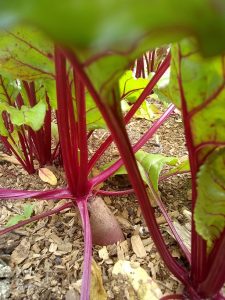If you're new here, you may want to subscribe to my RSS feed. Thanks for visiting!
by Kara Stiff
The hot weather is definitely here in North Carolina, in spite of an oddly slow start to the summer. All our usual steamy heat appears to have been redirected to Siberia this year. But though I’m definitely sweating, early July is the inflection point when cool spring crops finish up and hot-weather favorites come on in earnest. I’ve had a few handfuls of green peppers and heaps of basil and green beans, and I can see the cucumbers, zucchini, okra, and tomatoes will arrive shortly, but for the moment I’m still mostly eating spring crops like beets and carrots.
Eating Seasonally is More Interesting
I first started eating seasonally so I could save money by growing my own food, support my local economy, and have the freshest and most flavorful stuff. But that’s not why I keep doing it. The truth is I just personally find it more interesting than eating off the shelf. This sounds backwards! How could it be more interesting to keep on eating local apples every day from October to April, when I could get just about anything I craved at the store? When I first started eating seasonally, I thought I was in for some feelings of deprivation.
But I was wrong...I might be able to get a tasteless red tomato at Walmart every day of the year, but with my current growing system I can only have lumpy Cherokee Purples, sweet German Johnsons, tiny yellow Blonde Girls and pink Arkansas Travelers from July to October. And that’s fine. While they’re here I positively relish them every day, and preserve some as salsa, sauce and dehydrated.
By Halloween, I’m tired of fresh tomatoes, and not even interested in the flavorless impostors on the shelf. I’m not a purist. I might buy a store tomato during the winter. I’m always disappointed when I do, though, and it only makes me look forward to the garden variety all the more. It’s the same with everything I’ve successfully grown, from blueberries to melons to sweet potatoes to goat. I like my weird varieties that can’t be bought anywhere. I like to gorge when they’re here, and then forget about them and eat something else for a while, and then crave them before they arrive once again. It keeps life interesting, so I keep doing it, learning to eat what we grow and use up all the extra.
But What to Do With All Those Beets?

And now in July, when the sun is hammering down and the cilantro and lettuce have long since gone to seed, my spring planting of beets is still giving us calories. The trick is to find as many different ways to eat them as possible.
I pickled many pints, of course. My family loves pickles. They are an excellent candidate for home production because they’re fairly expensive to buy so it’s well worth my time to make them, plus they fit well into my no-cook lunch plan. This year I grew a variety called Cylindrical, which are big and long and carrot-shaped, conveniently yielding many slices of the same diameter for the pickle jar.
It’s also quite possible to freeze beets. I mince them first, and they thaw just fine. Part of the point of eating seasonally, though, is not to spend all my time preserving things, but to enjoy them when they’re here.
We enjoy our beets many ways. I cut them into coins and spread them in a pan, then chop the stems and leaves, toss them on top and sauté as a side dish. I make beet pie, which starts the same as that side dish, but then I whisk together six or eight eggs, a splash of milk, a few tablespoons of wheat or corn flour, some salt and pepper and some cream cheese or goat cheese. I pour that over top of the sautéed beets and cook very low, with some grated cheese on top. This turns a side dish into a full meal.
I roast some beets in the sun oven and sneak them into hummus for lunch, which is very pretty. I make beet fried rice, which is mostly minced beets and only a little leftover rice, plus scrambled eggs, other veg, ginger, garlic and soy sauce. I mince some more, cook them with pasta risotto-style and top with goat cheese. I think the kids love that one mostly for the brilliant pink color.
Abundance that Dovetails
When things come on hard in the garden they do so in groups, so it makes my life easy to have recipes where the ingredients mature together. When there’s lots of beets there’s also lots of carrots and peas to have with that beet hummus, or to toss in beet fried rice. When there’s lots of carrots there’s also the first spring milk from the goats, enough to make dips like soft cheeses or ranch dressing from homegrown kefir. When there’s extra milk the wild blackberries are soon to ripen, which means lots of beautiful purple breakfast smoothies.


Luckily, whey is both versatile and valuable. We try to moderate our carbohydrates around here to avoid diabetes and other health problems, so whenever we eat carbs I try to make sure the dish also contains healthy fats, protein, micro nutrients and fiber. Whey retains much of the sugar that was in the milk, but it also carries lots of the vitamins and minerals as well as protein. Whey can replace the milk or water in pancakes, muffins and bread, giving a nice texture. It can also replace the water in cooked rice, pasta, grits and beans.
As summer progresses, the cohorts change. When the last of the carrots are gone from the cooler we’ll have our hummus with cucumbers instead, and piles of melon besides. So many of our most beloved recipes were created specifically to use up seasonal abundance. I’m looking forward to eggplant baked or sautéed with tomatoes, basil and goat cheese. And black eyes peas with okra and tomatoes. And coconut curried sweet potato greens with Thai basil, which is even now hanging fragrantly over the garden path, begging to be cut back.
Relief from the Illusion and Tyranny of Choice
Any American who has traveled abroad for long periods might have had this common experience: you come home and go to the store to fill up the cupboards, but you just stop dead and stare at the strangeness before you, which didn’t look strange at all before you went away. There are 47 kinds of pasta sauce. There are 39 varieties of crackers.
The variety is bewildering, paralyzing, and completely unlike the offerings available in many other places. This is the tyranny of too much choice, which has been proven to make it harder, not easier, to make a decision. But as you stand and look at the bounty, you might notice there’s no meaningful difference between the many dozens of offerings. Sure, there’s 47 kinds of pasta sauce, but it’s all tomato. There’s no pesto cream. At our house we call this the illusion of choice. A choice between more of the same.
For more ideas on eating in season, check out this PDF: The Seasonal Kitchen Companion
Eating seasonally partly relieves me of both the tyranny and the illusion of choice. My husband would eat nachos three nights a week until he dies, but if I’ve had my favorite dish this week, I don’t want it again next week. I’ll dither about dinner, sometimes even after I’ve started cooking it. Out of all the possible things I could eat, is this what I really want?
That’s the wrong question because it’s a recipe for disappointment. But as a seasonal eater, the question becomes: how can I most deliciously use up all these beets? That is a recipe for creativity, surprise and yummy fun, in addition to a full belly.
What do you grow or buy in season, and how do you use it all up?
About Kara
Kara Stiff grew up in Anchorage, Alaska and got her BS in Sustainable Agriculture from the University of Maine. Now she lives with her husband, two small children and some number of goats on 17 acres in rural North Carolina. She documents her family’s journey toward resilience, community engagement and a lower environmental impact at low-carbonlife.org.

















